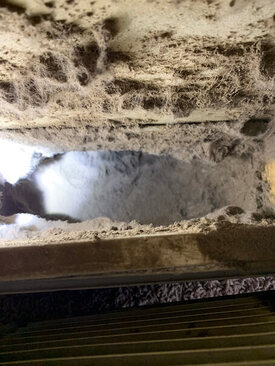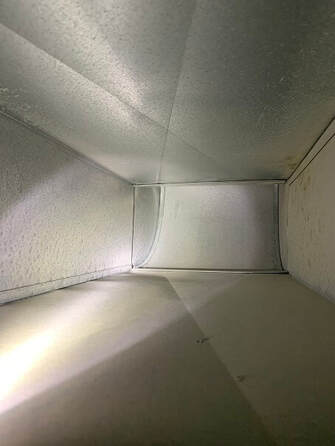|
Air ducts can get pretty dirty. Disgusting even, as the below photo shows. When your home's air ducts look like this, a run-of-the-mill air duct cleaning job isn't going to cut it. Why? Most basic-level air duct cleaning services feature high-pressured air as the mover of debris. But when said debris is abundant or "clingy" (e.g. drywall dust, pet fur), a more aggressive method is called for. Cleaning the branch lines The photo above was taken by one of our technicians in the branch line of a Minneapolis home, built in 2001, whose ducts had never been cleaned. As you can see, a lot of the debris is clinging to the walls of the duct, and the buildup is extensive. If this duct were to be cleaned with mere air pressure, a good deal of the debris would be pushed down the branch line into the main trunk for the vacuum to gobble up. But an unacceptable amount would be left behind, still clinging to the duct walls. During the Ultimate Duct Cleaning, the first step of the process is for the technician to slip a tool called the Viper Microline down the branch line. Its single flexible-plastic tentacle is ideal for the snug confines of a branch line. When this tool is engaged, it thrashes quickly and vigorously every which way inside the duct, dislodging debris from the duct walls and sending it airborne. The tool moves slowly down the vent and through the duct, with its forward-blowing air nozzle blasting the debris in front of it as it moves, pushing it toward the trunk lines. The technician will take the Microline to each branch-line vent, pushing the accumulative mass of debris into the trunk lines before moving to clean those. It is this physical contact of the tool with every inch of the duct wall that makes this level of cleaning so effective. Even stubbornly clinging dust stands no chance against the physical force of the Microline, as shown above. Cleaning the trunk lines Once the branch lines have been whipped, the technician moves to the main trunk lines to clean the debris accumulated from above. Because these ducts are much larger, the tool of choice here is the Viper Clean Sweep. This tool features six 16-inch long flexible-plastic tentacles, ideal for the roominess of main trunk lines. With an industrial vacuum in place at an access point created just before the furnace in the main return line, the technician inserts the tool—it requires only a 1-inch access point--at the other end. From there the action is similar to that of the Microline but on a larger scale. As the multiple tentacles whip aggressively to and fro inside the duct, debris is dislodged and rendered airborne. The forward-blowing air nozzles send airborne debris toward the vacuum, and debris that isn't airborne is pushed forward by the thrashing of the tentacles. Either way, the collective fate of the debris is to be whooshed down the vacuum at the end of the line. The process is then repeated in the main supply line. No top-of-the-line air duct cleaning would be complete without cleaning the furnace—the heart of the HVAC system. Since most homes with dirty ducts also have dirty furnaces, and since a dirty furnace will cause dirty air to move into the ducts, it makes sense to clean them both at once. Letting the tool speak for itself . . . No number of action words strung together in a sentence can convey the effectiveness of a tool better than a video of it in action:
0 Comments
Your comment will be posted after it is approved.
Leave a Reply. |
SearchArchives
April 2022
|
Twin Cities Furnace Cleaning - Open 7 Days a Week 8AM to 8PM




